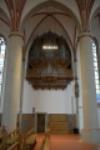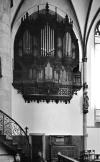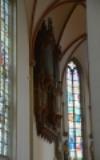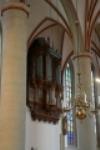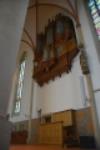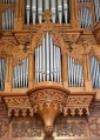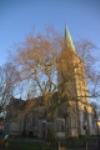Ausführliche Beschreibung der vorgewählten Orgel
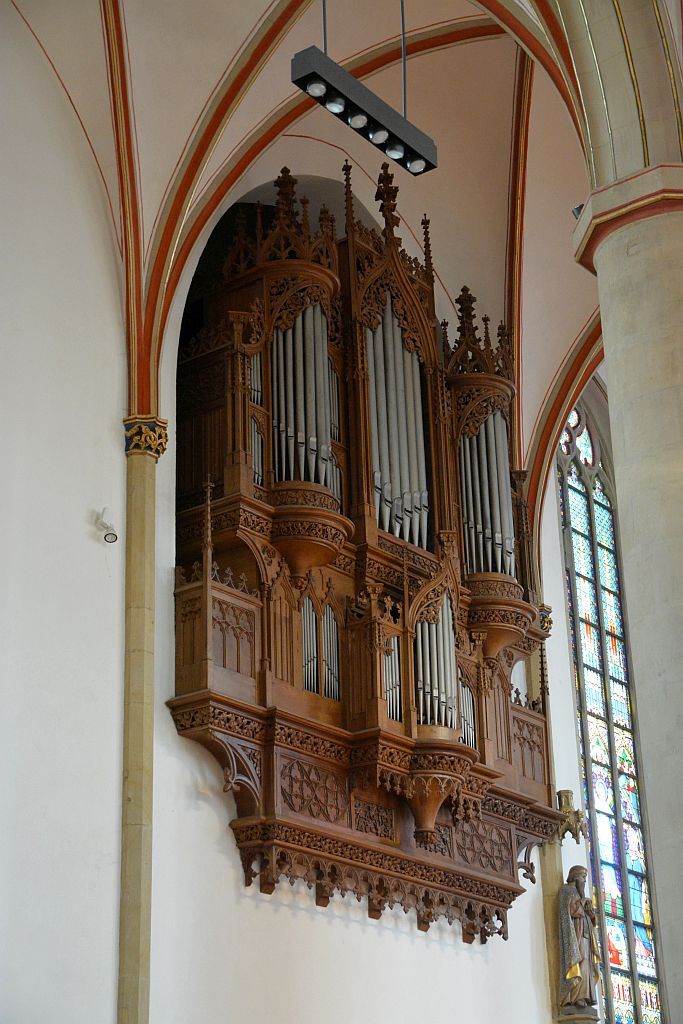
Bild: Piet Bron
Lüdinghausen, Deutschland (Nordrhein-Westfalen) - Katholische Pfarrkirche Sankt Felizitas
Gemeinde: Lüdinghausen
Adresse: Mühlenstraße 7, 59348, Lüdinghausen
Website: https://www.stfelizitas.de/
Beschreibung nr.: 2009363.
Gebaut von: Alfred Führer Orgelbau (1983)
Die Orgel enthält älteren Material: Organ case aus 1870 von Josef Laudenbach, Pipes aus ca. 1900 von Georg Stahlhuth & Sohn
In 1870 Josef Laudenbach built an organ for the St. Felizitaskirche in Lüdinghausen. The organ case of this organ has been preserved. The interior was replaced around 1900 by a larger organ of Stahlhuth with pneumatic action. Because this organ had fallen sharply in decay, it was replaced in 1983 by a new organ from Alfred Führer in the Laudenbach case, and with the re-use of much of Stahlhuth's pipe work. It is a three-manual organ with 41 stops.
Technische Daten
Disposition
Hauptwerk (C-a'''): Bordun 16' - 1904, Principal 8' - 1904, Gamba 8' - 1904, Gedackt 8' - 1904, Oktave 4', Querflöte 4' - 1904, Gemshorn 2', Rauschpfeife 2 fach (2 2/3'), Mixtur 5 fach (1 1/3'), Fagott 16', Trompete 8'.
Positiv (C-a'''): Gedackt 8', Quintdena 8', Venezianflöte 4', Nasat 2 2/3', Principal 2', Terz 1 3/5', Sifflöte 1 1/3', Oktave 1', Zimbel 3 fach (2/3'), Vox Humana 8', Tremulant.
Schwellwerk (C-a'''): Italienisch Principal 8' - 1904, Rohrflöte 8' - 1904, Vox Coelestis 8' - 1904, Principal 4', Blockflöte 4', Waldflöte 2', Sesquialtera 2 fach, Scharf 4 fach (1'), Schalmey 16', Oboe 8' - 1904, Tremulant.
Pedal (C-f'): Principalbass 16' - 1904, Subbass 16' - 1904, Oktavbass 8' - 1904, Spitzflöte 8', Choralbass 4' - 1904, Nachthorn 2', Hintersatz 4 fach (2 2/3'), Posaune 16' - 1904, Trompete 8', Trompete 4'.
Koppeln: Hauptwerk - Positiv, Hauptwerk - Schwellwerk, Pedal - Hauptwerk, Pedal - Positiv, Pedal - Schwellwerk.
Nebenregister und Spielhilfen: 2 freie Kombinationen, 1 freie Pedalkombination, Plenum A, Plenum B, Mixturen ab, Zungen ab, Zungeneinzelabsteller.

Bild: Piet Bron
Lüdinghausen, Deutschland (Nordrhein-Westfalen) - Katholische Pfarrkirche Sankt Felizitas
Gemeinde: Lüdinghausen
Adresse: Mühlenstraße 7, 59348, Lüdinghausen
Website: https://www.stfelizitas.de/
Beschreibung nr.: 2009363.
Gebaut von: Alfred Führer Orgelbau (1983)
Die Orgel enthält älteren Material: Organ case aus 1870 von Josef Laudenbach, Pipes aus ca. 1900 von Georg Stahlhuth & Sohn
| Jahr | Orgelbauer | Opus | Aktivität | 1870 | Josef Laudenbach | Neubau | ca. 1900 | Georg Stahlhuth & Sohn | Neubau im alten Gehäuse | 1983 | Alfred Führer Orgelbau | Neubau im alten Gehäuse |
In 1870 Josef Laudenbach built an organ for the St. Felizitaskirche in Lüdinghausen. The organ case of this organ has been preserved. The interior was replaced around 1900 by a larger organ of Stahlhuth with pneumatic action. Because this organ had fallen sharply in decay, it was replaced in 1983 by a new organ from Alfred Führer in the Laudenbach case, and with the re-use of much of Stahlhuth's pipe work. It is a three-manual organ with 41 stops.
Technische Daten
| Anzahl Register pro Manual | |
| - Hauptwerk | 11 |
| - Positiv | 10 |
| - Schwellwerk | 10 |
| - Pedal | 10 |
| Gesamtzahl der Stimmen | 41 |
| Tastentraktur | Mechanical |
| Registertraktur | Electrical |
| Windlade(n) | Slider chests |
Disposition
Hauptwerk (C-a'''): Bordun 16' - 1904, Principal 8' - 1904, Gamba 8' - 1904, Gedackt 8' - 1904, Oktave 4', Querflöte 4' - 1904, Gemshorn 2', Rauschpfeife 2 fach (2 2/3'), Mixtur 5 fach (1 1/3'), Fagott 16', Trompete 8'.
Positiv (C-a'''): Gedackt 8', Quintdena 8', Venezianflöte 4', Nasat 2 2/3', Principal 2', Terz 1 3/5', Sifflöte 1 1/3', Oktave 1', Zimbel 3 fach (2/3'), Vox Humana 8', Tremulant.
Schwellwerk (C-a'''): Italienisch Principal 8' - 1904, Rohrflöte 8' - 1904, Vox Coelestis 8' - 1904, Principal 4', Blockflöte 4', Waldflöte 2', Sesquialtera 2 fach, Scharf 4 fach (1'), Schalmey 16', Oboe 8' - 1904, Tremulant.
Pedal (C-f'): Principalbass 16' - 1904, Subbass 16' - 1904, Oktavbass 8' - 1904, Spitzflöte 8', Choralbass 4' - 1904, Nachthorn 2', Hintersatz 4 fach (2 2/3'), Posaune 16' - 1904, Trompete 8', Trompete 4'.
Koppeln: Hauptwerk - Positiv, Hauptwerk - Schwellwerk, Pedal - Hauptwerk, Pedal - Positiv, Pedal - Schwellwerk.
Nebenregister und Spielhilfen: 2 freie Kombinationen, 1 freie Pedalkombination, Plenum A, Plenum B, Mixturen ab, Zungen ab, Zungeneinzelabsteller.
| Literatur |
|
| Weblinks |
https://www.kirchenmusik-felizitas.de/st-felizitas/orgel-in-st-felizitas/disposition/ |


